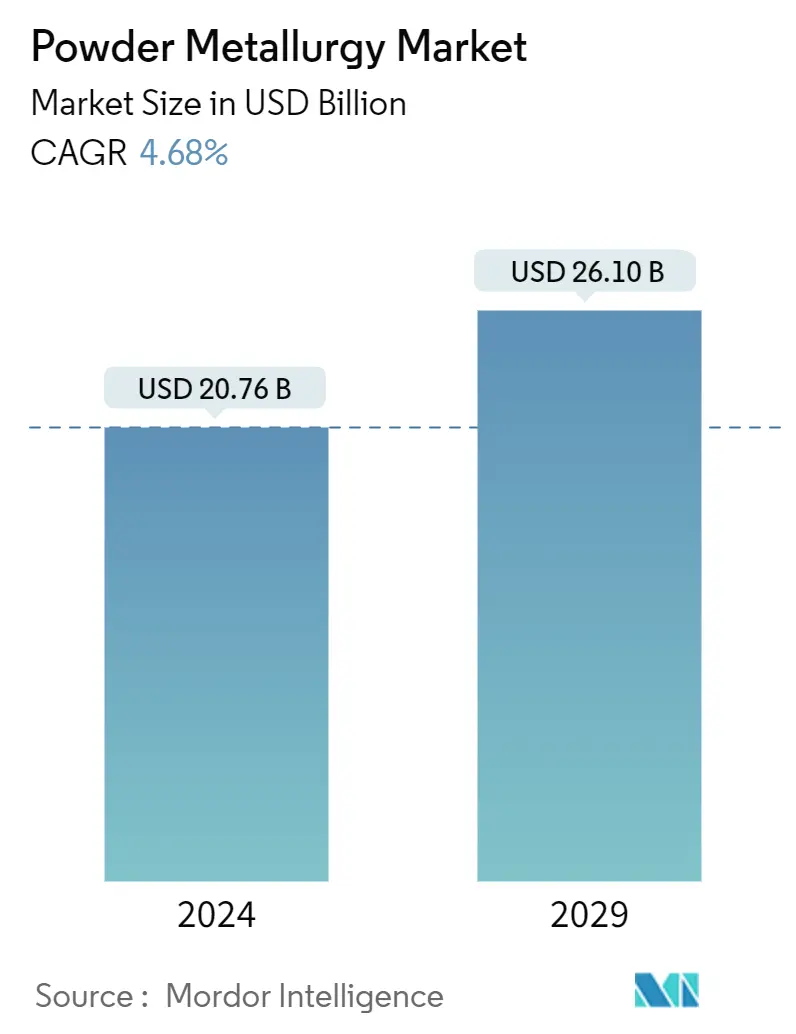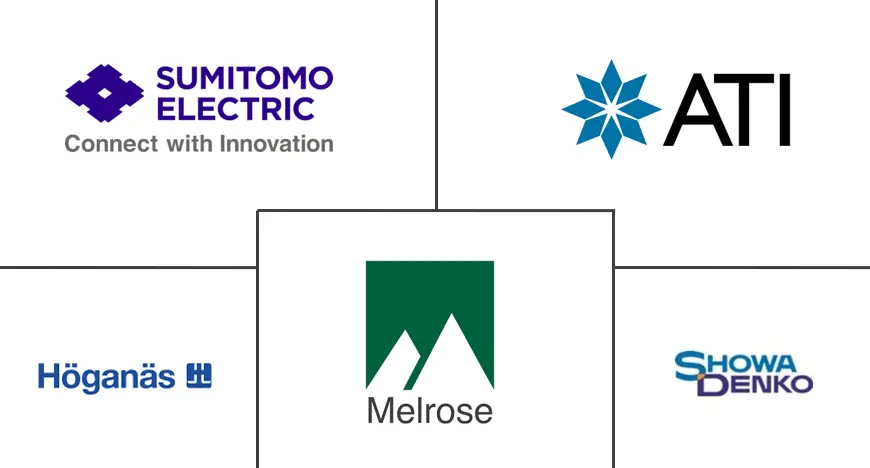Market Size of Powder Metallurgy Industry

| Study Period | 2019 - 2029 |
| Market Size (2024) | USD 20.76 Billion |
| Market Size (2029) | USD 26.10 Billion |
| CAGR (2024 - 2029) | 4.68 % |
| Fastest Growing Market | Asia-Pacific |
| Largest Market | Asia-Pacific |
| Market Concentration | High |
Major Players
*Disclaimer: Major Players sorted in no particular order |
Powder Metallurgy Market Analysis
The Powder Metallurgy Market size is estimated at USD 20.76 billion in 2024, and is expected to reach USD 26.10 billion by 2029, growing at a CAGR of 4.68% during the forecast period (2024-2029).
In 2020, COVID-19 negatively impacted the market. However, the market has now been estimated to have reached pre-pandemic levels and is expected to grow steadily in the future.
- Powder metallurgy is being used more and more by automotive OEMs, which is one of the main things driving the market. Moreover, the growing implementation of electrical and electromagnetic applications is also expected to provide market growth.
- On the other hand, rising costs of raw materials and tools are likely to slow the market's growth.
- The increasing adoption of powder metallurgy in the medical field along with the rapid growth in the aerospace and defense sector is expected to provide opportunities to the market.
- The Asia-Pacific region led the market for powder metallurgy, and it is expected to have the highest growth rate over the next few years.
Powder Metallurgy Industry Segmentation
Powder metallurgy is a way to make things that use less energy and have better performance and more design options than traditional methods like casting, forging, extrusion, stamping, and machining.
The powder metallurgy market is segmented by product type, application, and geography. By product type, the market is segmented into ferrous and non-ferrous metals. By application, the market is segmented into automotive, industrial machinery, electrical and electronics, aerospace, and other applications. The report also covers the market size and forecasts in 15 countries across major regions. For each segment, market sizing and forecasts have been done based on revenue (USD).
| Product Type | |
| Ferrous | |
| Non-ferrous |
| Application | |
| Automotive | |
| Industrial Machinery | |
| Electrical and Electronics | |
| Aerospace | |
| Other Applications |
| Geography | |||||||
| |||||||
| |||||||
| |||||||
| |||||||
|
Powder Metallurgy Market Size Summary
The powder metallurgy market is poised for steady growth, driven by its increasing application in the automotive sector, particularly among original equipment manufacturers (OEMs). The technology's ability to produce parts with complex geometries and high dimensional accuracy makes it ideal for automotive components such as bearings, gears, and various other vehicle parts. The market is also benefiting from the rising adoption of powder metallurgy in the medical field and the rapid expansion of the aerospace and defense sectors. However, challenges such as the rising costs of raw materials and tools may temper growth. The Asia-Pacific region, with its robust economic growth and burgeoning automotive and aerospace industries, is expected to lead the market, offering significant opportunities for expansion.
The Asia-Pacific region, particularly countries like China, India, and Japan, is becoming a pivotal market for powder metallurgy due to its expanding economy and increasing consumer spending. China's status as the largest automotive production base globally, coupled with the growth of the electric vehicle market, is a significant driver of demand for powder metallurgy products. Similarly, India's automotive industry is witnessing growth, further bolstering market prospects. The region's aerospace industry is also on an upward trajectory, contributing to the market's expansion. The powder metallurgy market is characterized by a consolidated landscape, with key players such as Melrose Industries PLC, Sumitomo Electric Industries, Ltd., and Höganäs AB actively enhancing their market presence through strategic initiatives and expansions.
Powder Metallurgy Market Size - Table of Contents
-
1. MARKET DYNAMICS
-
1.1 Drivers
-
1.1.1 Increasing Preference for Powder Metallurgy by Automotive OEMs
-
1.1.2 Growing Implementation in Electrical and Electromagnetic Applications
-
-
1.2 Restraints
-
1.2.1 Increasing Raw Material and Tooling Costs
-
1.2.2 Other Restraints
-
-
1.3 Industry Value Chain Analysis
-
1.4 Porter's Five Forces Analysis
-
1.4.1 Bargaining Power of Suppliers
-
1.4.2 Bargaining Power of Consumers
-
1.4.3 Threat of New Entrants
-
1.4.4 Threat of Substitute Products and Services
-
1.4.5 Degree of Competition
-
-
-
2. MARKET SEGMENTATION (Market Size in Value)
-
2.1 Product Type
-
2.1.1 Ferrous
-
2.1.2 Non-ferrous
-
-
2.2 Application
-
2.2.1 Automotive
-
2.2.2 Industrial Machinery
-
2.2.3 Electrical and Electronics
-
2.2.4 Aerospace
-
2.2.5 Other Applications
-
-
2.3 Geography
-
2.3.1 Asia-Pacific
-
2.3.1.1 China
-
2.3.1.2 India
-
2.3.1.3 Japan
-
2.3.1.4 South Korea
-
2.3.1.5 Rest of Asia-Pacific
-
-
2.3.2 North America
-
2.3.2.1 United States
-
2.3.2.2 Canada
-
2.3.2.3 Mexico
-
-
2.3.3 Europe
-
2.3.3.1 Germany
-
2.3.3.2 United Kingdom
-
2.3.3.3 Italy
-
2.3.3.4 France
-
2.3.3.5 Rest of Europe
-
-
2.3.4 South America
-
2.3.4.1 Brazil
-
2.3.4.2 Argentina
-
2.3.4.3 Rest of South America
-
-
2.3.5 Middle-East and Africa
-
2.3.5.1 Saudi Arabia
-
2.3.5.2 South Africa
-
2.3.5.3 Rest of Middle-East and Africa
-
-
-
Powder Metallurgy Market Size FAQs
How big is the Powder Metallurgy Market?
The Powder Metallurgy Market size is expected to reach USD 20.76 billion in 2024 and grow at a CAGR of 4.68% to reach USD 26.10 billion by 2029.
What is the current Powder Metallurgy Market size?
In 2024, the Powder Metallurgy Market size is expected to reach USD 20.76 billion.

